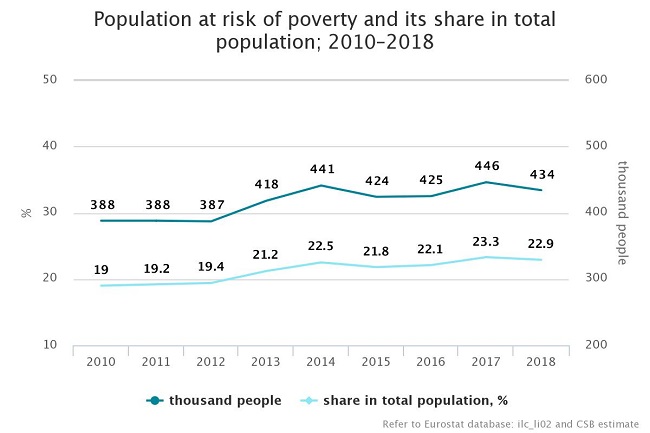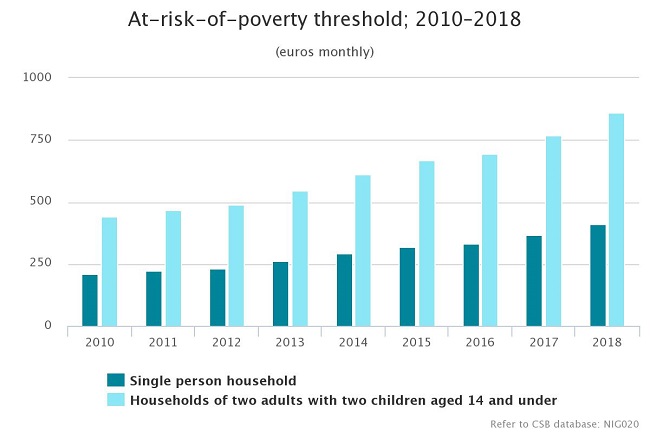Analytics, Latvia, Quality of life, Statistics
International Internet Magazine. Baltic States news & analytics
Tuesday, 16.04.2024, 12:23
Latvia: Decline in population at risk of poverty
 Print version
Print versionDrop in the at-risk-of-poverty rate was facilitated by the rise in minimum wage (from EUR 380 in 2017 to EUR 430 in 2018), changes in legislation on social benefits (recalculation of separate pensions, greater support to foster families and families having two and more children), as well as changes in population income tax application.


At-risk-of-poverty rate is declining among children and stays stable among elderly population
At-risk-of-poverty rate in single-parent and large families has reduced significantly, compared to the year before. In 2018, 26.2% of families consisting of one adult with children (32.6% in 2017) and 16.7% of large families consisting of two adults with three or more children (20.7% in 2017) were at risk of poverty. For the fifth year in a row at-risk-of-poverty rate among children aged 17 and under has been reducing (in 2018 it constituted 14.5% and in 2017 – 17.5%).
The highest at-risk-of-poverty rate may still be observed among single elderly population aged 65 and over. In 2018, this share constituted 74.9% (in 2017 those were 74.0%). The second highest at-risk-of-poverty rate was registered among single persons aged 64 and under – 31.7% (31.0% in 2017).
The lowest at-risk-of-poverty rate was recorded among working population (8.5% in 2018 and 8.1% in 2017). Significantly higher at-risk-of-poverty risk was observed among unemployed population (57.7% in 2018 and 59.5% in 2017) and pensioners (52.5% in 2018 and 48.9% in 2017).
Over the last years, influence of social transfers3 on the population income has been declining. However, in 2018 this influence increased again. In 2018, support received from social transfers reduced the share of people at risk of poverty by 16.4 percentage points. Without social transfers 39.3% of people would be at risk of poverty. In 2017, social transfers diminished risk of poverty by 15.8 percentage points and in 2016 by 17.8 percentage points.
More information on poverty and social exclusion risks is available in the informative leaflet People at Risk of Poverty and Social Exclusion in Latvia in 2018 (in Latvian) and CSB database section Monetary poverty and income inequality.
Poverty and social exclusion indicators are acquired with the help of the European Union Statistics on Income and Living Conditions (EU-SILC) survey 2019 conducted by the CSB. The survey covered 5.3 thousand households and 9.6 thousand respondents aged 16 and over. The CSB will collect data on household poverty risk in 2019 within the framework of the survey of 2020, and respondents will have the possibility to fill in the questionnaire online.
- 28.01.2022 BONO aims at a billion!
- 25.01.2021 Как банкиры 90-х делили «золотую милю» в Юрмале
- 30.12.2020 Накануне 25-летия Балтийский курс/The Baltic Course уходит с рынка деловых СМИ
- 30.12.2020 On the verge of its 25th anniversary, The Baltic Course leaves business media market
- 30.12.2020 Business Education Plus предлагает анонсы бизнес-обучений в январе-феврале 2021 года
- 30.12.2020 Hotels showing strong interest in providing self-isolation service
- 29.12.2020 В Латвии вводят комендантский час, ЧС продлена до 7 февраля
- 29.12.2020 В Rietumu и в этот раз создали особые праздничные открытки и календари 2021
- 29.12.2020 Latvia to impose curfew, state of emergency to be extended until February 7
- 29.12.2020 18-19 января Наталия Сафонова проводит семинар "Управленческий учет во власти собственника"








 «The Baltic Course» Is Sold and Stays in Business!
«The Baltic Course» Is Sold and Stays in Business!

